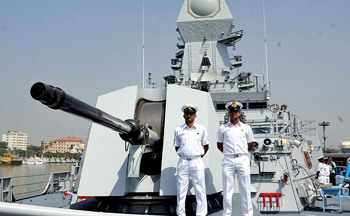Mumbai, Sept 30: Naval warship INS Kochi, a stealth guided missile destroyer, was commissioned today by Defence Minister Manohar Parrikar, who said the navy has chalked out an indigenisation plan for the next 15 years.

"We will develop a real blue-water navy which will dominate the Indian Ocean region," Parrikar said, adding, "We still lack in fire power."
The minister also spoke of a 'mixed success' on the missile system technology front. "In the next 5 years there will be indigenisation to a large extent in missile technology," he said.
The finish of the INS Kochi is as "good as any foreign (naval) ship", he said, lauding those who built it.
INS Kochi is the second ship of the Kolkata-class (Project 15A) guided missile destroyers. The contract for three ships of Kolkata class was signed as a follow-on of the legendary Delhi-class destroyers, which were commissioned into the navy more than a decade ago.
Designed by the navy's in-house organisation, Directorate of Naval Design, and constructed by Mazagon Dock Ship Builders Ltd in Mumbai, the ship is christened after the vibrant port city of Kochi.
Although conceived as follow-on of the earlier Delhi class, this ship is vastly superior and has major advancements in weapons and sensors. The ship incorporates new design concepts for improved survivability, stealth, sea-keeping and manoeuvrability.
With a displacement of 7,500 tons, the majestic ship spanning 164 metres in length and 17 metres at the beam, is propelled by four gas turbines and designed to achieve speeds in excess of 30 knots.
The ship has a complement of about 40 officers and 350 sailors. The accommodation and living spaces have been designed with special emphasis on ergonomics and habitability.
Enhanced stealth features have been achieved through shaping of hull and use of radar-transparent deck fittings. A bow mounted sonar dome, the second of its kind in an indigenous naval platform, has been introduced to enhance sonar acoustic performance, according to a navy spokesperson.
To a question on shortage of naval helicopters, Parrikar said, "We are around 35-40 per cent of overall indigenisation target. The rest of the things are partly or fully imported.
"In case where quantity is less, it is not feasible to make the things. The target of 70 per cent indigenisation over a period of next five to six years is a reasonable target," he said.
INS Kochi is packed with an array of sophisticated weapons and sensors, with a significant indigenous component. The ship has many lethal weapons to her credit which include the successful fitment of vertically launched missile system for long distance engagement of shore and sea-based targets.
The vessel is one of the few warships in the world and the second in the Indian Navy to have multi-function surveillance and threat alert radar to provide target data to long-range surface-to-air missile system.
The MF STAR and LR SAM systems are jointly developed by DRDO (Defence Research and Development Organisation) and Israel Aerospace Industries Ltd. To protect against incoming air borne and surface threats, at medium and close in range, the ship has 76 mm and 30 mm gun mounts.
The ship can be classified as a 'network of networks' as it is equipped with ship data network (SDN), combat management system (CMS), automatic power management system (APMS) and auxiliary control system (ACS).





Comments
Add new comment